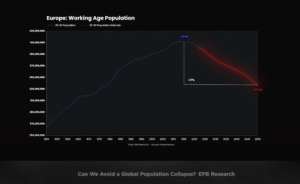Growing up, it came as a surprise to me that population growth is not an ever-increasing process; it has its tipping point. It’s beyond certain that we won’t reach 12 billion, with several estimates suggesting that we will never reach 11 billion.
There’s a missing page in our chapters about population studies that fails to address the certainty of population decline and the potential consequences we must be aware of as a civilization. Without the right interventions, a shrinking population can spiral into a significant problem, threatening the economic stability and balance of our societies. While there are many good reasons to believe this isn’t inevitable, the lack of coverage in traditional educational materials creates a need for alternative mediums to inform the public about this subject.
Consider this article an attempt to fill that gap: providing a brief overview.
Declining Fertility Rate
Let’s begin with a basic figure: 2.1. This is the global replacement fertility rate required for a population to remain stable. The “2” represents the number of children needed to replace the parents, and the additional “0.1” accounts for child mortality rates.
During the latter half of the 20th century, the global population experienced a significant increase. However, current trends show a stark decline in fertility rates in some of the world’s most populous countries. For instance, recent data shows China’s fertility rate has plummeted to 1.16, India’s to 2.03, the United States’ to 1.66, Japan’s to 1.30, and South Korea’s, one of the lowest, at 0.81.
These figures indicate that these countries are certain to see population declines. This phenomenon is already evident several countries, including some of the most populated ones.

What are the Challenges of Population Decline?
The challenges associated with population decline are primarily economic. Modern economies rely on large workforces to maintain growth and productivity. A shrinking population means fewer workers, which can hinder economic performance.
When there are fewer births, it creates an increased old age dependency ratio. This ratio measures the number of elderly dependents (those typically aged 65 and over) compared to the working-age population. As the ratio increases, it means there are fewer young earners to support a growing number of dependents, both elderly and children. Our economic model heavily relies on taxes collected from workers to fund welfare programs. With fewer people working and more dependents, the sustainability of welfare systems becomes compromised.

Some experts predict that once population decline begins, it can lead to a steep and difficult-to-reverse downward trend. Maintaining economic growth in the face of a declining population is exceptionally challenging. Economic instability can cause significant societal problems, with a potential collapse of a functioning system being the worst-case scenario. While some economists are concerned about these extreme dangers, others believe that technological advancements may help mitigate the impact.
Is it Preventable?
For developed countries, addressing population decline in the short term is feasible through immigration. However, this is not a global solution. Also, even within the developed world, not all countries are open to rapid influxes of people from the developing world. Even countries that welcome a lot of immigrants often express concerns about managing large-scale immigration.
Utilizing artificial intelligence (AI) to fill workforce gaps is another potential solution. Japan, for example, has begun to integrate AI in certain fields to compensate for labor shortages. However, many professions still require human intervention, and replacing human labor with AI is currently an expensive and technically challenging endeavor. This is a complex issue, and opinions vary on the feasibility and effectiveness of AI as a long-term solution.
These are multifaceted issues with no easy answers, and the situation will get clearer into the future as we have more understanding of the underlying factors and potential solutions.
Why Wasn’t This Taught to Us?
In the 20th century, the world witnessed a dramatic surge in population, primarily fueled by advancements in healthcare. As medical interventions improved, fewer children died in infancy, and people generally lived longer, significantly increasing the average lifespan. For instance, from 1850 to 1950, the global population rose from approximately 1.2 billion to 2.5 billion, and then reached to 6 billion by the year 2000. This rapid growth sparked concerns and created a prevailing sense of urgency that it could lead to catastrophic outcomes if left unchecked.

Despite the availability of knowledge that population growth would eventually stabilize and even decline, the curriculum in many educational systems did not reflect this. The reason here is likely rooted in the anxiety provoked by the sudden population increase. During this period, educational content might have been influenced more by the immediate fears of unchecked population growth, rather than a balanced outlook that included the potential for eventual decline. This focus on rapid growth and the potential consequences must have overshadowed discussions about the future possibilities of population stabilization and decline, leaving a gap in our understanding of demographic transitions.
Our education on population dynamics wasn’t incorrect but incomplete. It’s essential to include both growth and decline in current and future educational frameworks. Learing about population decline is not only interesting but also crucial for better awareness of demographic trends.






